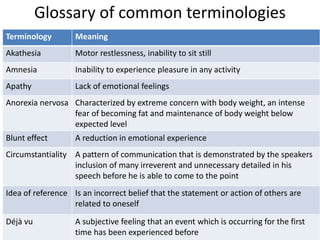The document provides definitions for various psychiatric and psychological terminology. It includes terms related to abnormal behaviors, personality, defense mechanisms, neurotransmitters, and alternative therapeutic modalities. Specifically, it defines terms like akathesia, amnesia, delusion, euphoria, repression, projection, acetylcholine, family therapy, and more. It also categorizes abnormal behaviors into disorders of consciousness, thought, affect, perception, memory, and others.















































































